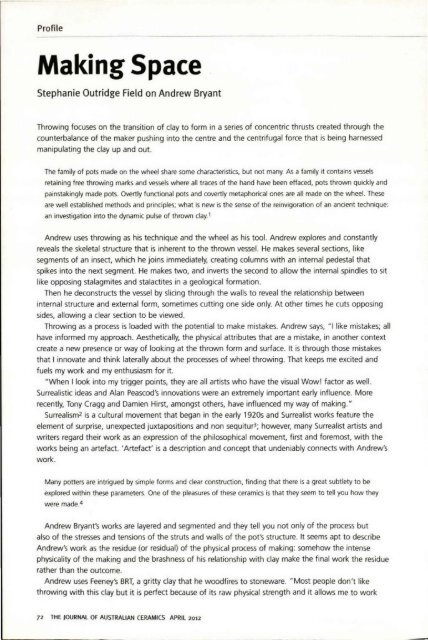The Journal of Australian Ceramics Vol 51 No 1 April 2012
Create successful ePaper yourself
Turn your PDF publications into a flip-book with our unique Google optimized e-Paper software.
Pr<strong>of</strong>ile<br />
Making Space<br />
Stephanie Outridge Field on Andrew Bryant<br />
Throwing focuses on the transition <strong>of</strong> clay to form in a series <strong>of</strong> concentric thrusts created through the<br />
counterbalance <strong>of</strong> the maker push ing into the centre and the centrifugal force that is being harnessed<br />
manipulating the clay up and out.<br />
<strong>The</strong> family <strong>of</strong> pots made on the wheel sha re some characteristics, but not many. As a family it contains vessels<br />
retain ing free throwing marks and vessels where all traces <strong>of</strong> the hand have been effaced, pots thrown quickly and<br />
painstakingly made pots. Overtly functional pots and covertly metaphorical ones are all made on the wheel. <strong>The</strong>se<br />
are well established methods and principles; what is new is the sense <strong>of</strong> the reinvigoration <strong>of</strong> an ancient technique:<br />
an investigation into the dynamic pulse <strong>of</strong> thrown clay. 1<br />
Andrew uses throwing as his technique and the wheel as his tool. Andrew explores and constantly<br />
reveals the skeletal structure that is inherent to the thrown vessel. He makes several sections, like<br />
segments <strong>of</strong> an insect, which he joins immediately, creating columns with an internal pedestal that<br />
spikes into the next segment. He makes two, and inverts the second to allow the internal spindles to sit<br />
like opposing stalagmites and stalactites in a geological formation.<br />
<strong>The</strong>n he deconstructs the vessel by slicing through the walls to reveal the relationship between<br />
internal structure and external form, sometimes cutting one side only. At other times he cuts opposing<br />
sides, allowing a clea r section to be viewed.<br />
Throwing as a process is loaded with the potential to make mistakes. Andrew says, "I like mistakes; all<br />
have informed my approach. Aesthetically, the physical attributes that are a mistake, in another context<br />
create a new presence or way <strong>of</strong> looking at the thrown form and surface. It is through those mistakes<br />
that I innovate and think laterally about the processes <strong>of</strong> wheel throwing. That keeps me excited and<br />
fuels my work and my enthusiasm for it.<br />
"When I look into my trigger points, they are all artists who have the visual Wow! factor as well.<br />
Surrealistic ideas and Alan Peascod's innovations were an extremely important early influence. More<br />
recently, Tony Cragg and Damien Hirst, amongst others, have influenced my way <strong>of</strong> making."<br />
Su rrealism 2 is a cultural movement that began in the early 1920s and Surrealist works feature the<br />
element <strong>of</strong> surprise, unexpected juxtapositions and non sequitur3; however, many Surrealist artists and<br />
writers regard their work as an expression <strong>of</strong> the ph ilosophical movement, first and foremost, with the<br />
works being an artefact. 'Artefact' is a description and concept that undeniably connects with Andrew's<br />
work.<br />
Many potters are intrigued by simple forms and clear construction, finding that there is a great subtlety to be<br />
explored within these parameters. One <strong>of</strong> the pleasu res <strong>of</strong> these ceramics is that they seem to tell you how they<br />
were made. 4<br />
Andrew Bryant's works are layered and segmented and they tell you not only <strong>of</strong> the process but<br />
also <strong>of</strong> the stresses and tensions <strong>of</strong> the struts and walls <strong>of</strong> the pot's structure. It seems apt to describe<br />
Andrew's work as the residue (or residual) <strong>of</strong> the physical process <strong>of</strong> making: somehow the intense<br />
physicality <strong>of</strong> the making and the brashness <strong>of</strong> his relationship with clay make the final work the residue<br />
rather than the outcome.<br />
Andrew uses Feeney's BRT, a gritty clay that he woodfires to stoneware. "Most people don't like<br />
throwing with this clay but it is perfect because <strong>of</strong> its raw physical strength and it allows me to work<br />
72 THE JOURNAL OF AUSTRALIAN CERAMICS APRIL <strong>2012</strong>

















